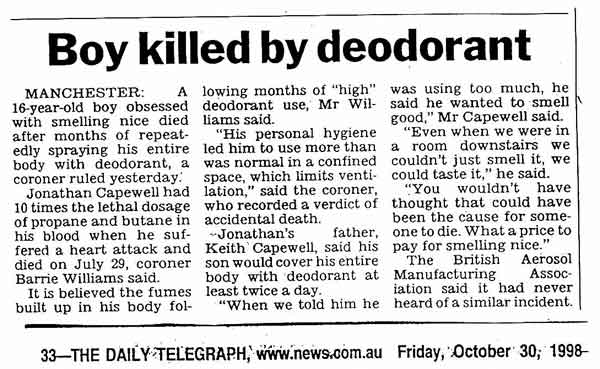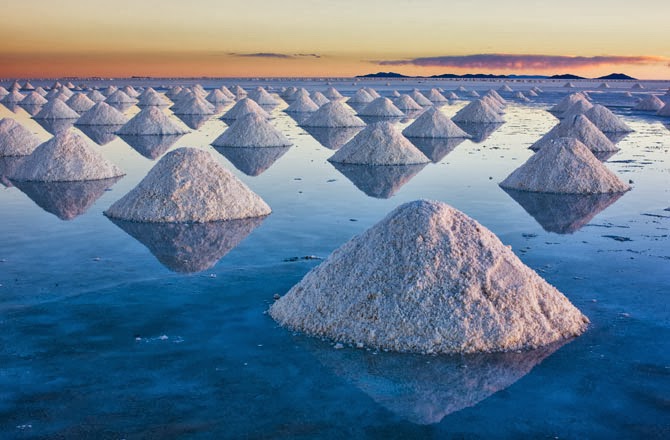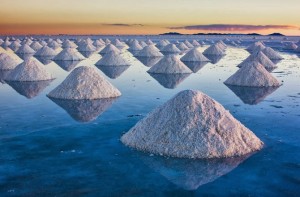
by JuneMary | Feb 17, 2012 | All Renewed Health Articles, Health Hazards |
For those who consciously choose to source, and use, safety conscious personal care products, it is not uncommon to hear that mainstream companies are catching up by also removing potentially harmful ingredients. That can only be of benefit to everyone.
We can become complacent over time, and take for granted the great products that we already use. It sometimes takes a wake up call to remind me of what we are blessed with.
One of those wake up calls came in a newspaper article recently. It reported the death of a boy in Manchester who apparently over-used a product that everyone simply takes for granted…..the common old deodorant.
What is interesting is that a similar article from a different newspaper, also reporting a similar tragedy, appeared dated 10 years previous.
According to the first report, the boy’s blood recorded 10 times the lethal dosage of propane and butane.
The second report, dated 10 YEARS later, reports the boy apparently died of cardiac arrythmia caused by exposure to solvents in the product. See images below
So what has changed in 10 years?
Well, it appears that there are at least some products out there that, in spite of accidental deaths occurring, still appear to contain ingredients that have the potential to cause death, if used in a manner not in accordance with the warnings on the container. And these are ONLY the deaths that have been recorded in the press that people have compiled. It would not be unreasonable to ask just how many deaths have occurred worldwide from using a deodorant – if such records exist.
An interesting point, is in the most recent media report, where in the last sentence it is stated that ….He (coroner) said that he was satisfied (manufacturer) gave enough warning on its cans that excessive amounts were not to be used in confined spaces.
So, in spite of at least one death having already been reported ten years earlier, the main focus appears to remain not on removing any potentially harmful ingredients, but ensuring to the coroner’s satisfaction that the label provides adequate warning. There does not appear to have been any focus on rectifying the concern by recommending the removal of any of the potentailly harmful ingredients that may have contibuted to both tragedies.
Where do most people use a deodorant? In the bathroom, possibly the second most confined room in the house.
Who EVER reads the label on a deodorant before use? And WHY would they? It’s only a deodorant after all, used by virtually everyone, at least once every single day.
It is definitely re–assuring to be able to source and use personal care products that, due to their ingredients, are NOT required to display health warnings and safety instructions for their use.


Deodorant Death 2008
by JuneMary | Feb 17, 2012 | All Renewed Health Articles, Health Hazards, Healthy Living |
It never ceases to amaze me that so many people will use the artificial sweetener, aspartame. Mind you most people will not realise the danger I would guess…it’s also in SO many products consumed daily by MANY people and they don’t know the potential problems associated with this product…
Aspartame, more commonly known as NutraSweet or Equal, is one of the most toxic substances being consumed today. The artificial sweetener, currently used in over 4,000 products worldwide, entertains a sordid past and has been one of the most tested and debated food additives in the history of the FDA. While the manufacturer maintains that aspartame is not a danger to your health, the scientific studies don’t necessarily agree.
The Ingredients of Aspartame
Aspartic Acid:
Aspartate is a neurotransmitter in the brain, facilitating information from one neuron to another. Too much aspartate allows an influx of calcium into the brain cells, triggering an excessive amount of free radicals which kill the cells. Aspartate is referred to as an “excitotoxin” because of the nerve cell damage that it causes. Many chronic illnesses have been attributed to long term excitotoxin exposure, including multiple sclerosis, ALS, memory loss, hormonal problems, hearing loss, epilepsy, Alzheimer’s disease, Parkinson’s disease, hypoglycemia, dementia, brain lesions and neuroendocrine disorders.
Phenylalanine:
Phenylalanine is an amino acid normally found in the brain. Human testing has shown phenylalanine levels in the blood are increased significantly in those who chronically use aspartame. Excessive levels of phenylalanine in the brain can cause the levels of serotonin to decrease, which can lead to depression, schizophrenia and make one more susceptible to seizures.
Methanol:
By far, the most controversial ingredient in aspartame is methanol (aka wood alcohol). An EPA assessment of methanol states that it is “considered a cumulative poison due to the low rate of excretion once it is absorbed. In the body, methanol is oxidated to formaldehyde and formic acid; both of these metabolites are toxic.” This oxidation occurs when methanol reaches 86 degrees F (30 degrees C).
Formaldehyde:
A product broken down from aspartate is a known carcinogen and causes retinal damage, birth defects and interferes with DNA replications. The EPA recommends a consumption limit of 7.8 mg/day. A 1 Liter aspartame sweetened beverage contains about 56 mg of methanol, seven times the EPA limit. The most common maladies related to methanol poisoning are vision problems including misty vision, progressive contraction of visual fields, blurring of vision, obscuration of vision, retinal damage and blindness.
Natural News has an article about Aspartame: Aspartame has been renamed and is now being marketed as a natural sweetener (Opens in a New Window.)
Aspartame’s Dangers, Side Effects and FDA Approval Explained – Mercola (Opens in a New Window.)

by JuneMary | Feb 17, 2012 | All Renewed Health Articles, Healthy Foods, Healthy Living, Nutrition, Optimum Health Topics |
“Salt is born of the purest of parents: the sun and the sea” – Pythagoras 580–500B.C.

Salt is born
When large oceans of ancient times evaporated, they left massive amounts of salt behind that was slowly dehydrated by the sun. Radial energies of the sun are one of the most potent forms of life force, so potent that all plant life sustains itself primarily through this energy. This happened at a time when pollution did not exist.
In one specific location in the Himalayas in Pakistan, these salt beds were exposed to very high pressure and temperatures, forcing a small portion of the salt to form an unusual crystalline structure, different from that found in all other salts with a higher degree of crystallization. Hence, a much higher life force field since crystallization is nature’s way of storing life force.
The life force field of Krystal salt gives it properties that make it far superior to any other type of natural unrefined salt. In repeated Russian experiments intake of brine 1% Krystal salt balances the entire meridian system of a person within 15 minutes.
Needless to say, Himalayan Krystal salt is mined using age–old manual methods, not using explosives or heavy machinery. The milling is carried out in controlled facilities, sorted, brine-washed and sun–dried in India under a regulatory body to get the highest standard possible.
Natural salt is not a medicine, but a food, much like apples, wheat, water and other natural substances. Salt is a core, essential group of nutrients with exceptional qualities and abilities fundamental to keeping us alive. In its original, wholesome, unadulterated form, there are some 84 known elements to be found in their bio-available state in this type of food, making it one of the most efficient foodstuffs available.
Europe for a long time sent asthma patients to the salt mines. They felt better after several hours per day for two weeks, and they remained free of symptoms for many months.
Sea Salt is increasingly polluted: industrial pollution, shipping accidents, sewage in rivers, both the chemical and energetic properties of the salt freshly harvested from the sea is compromised. Many of the predatory fish carry heavy metals in their flesh.
Table Salt is just sodium chloride. Much of what has become known about the negative effects of refined flour and sugar can be applied to salt. The food processing industry has been presenting us with refined, denatured sodium chloride enriched with iodine, aluminium and other ‘enhancements’ as ‘salt’, but natural salt is very different.
Usage of Water and Himalayan Krystal salt
Take ¼ to ½ teaspoon in the morning on the tongue after a pint of water. Hold it in hollowed tongue away from roof of mouth if possible. Allow salt to disperse and mix with saliva before swallowing. You need ½ teaspoon salt per day or ¼ teaspoon per 2 pints of water. So if necessary repeat the process after water in the evening.
You can bathe in Himalayan Salt. Bathing in Himalayan Salts for 15–30 minutes gives you the same effect as fasting for 3 days. 1–2 cups salt recommended.
“Slip into a sheer ocean of energy with these magical bath salts. Imagine taking a dip in the pristine primal ocean, some of 250 million years ago. Now you can. Relax, while your body absorbs the 84 vital nutrients and your skin attains the soft glow of health.”
Himalayan bath salts contain 84 essential minerals, more than any other bath salt, including magnesium, potassium, bromide and calcium which are readily absorbed into the skin during a 15–30 minute bathe.
Himalayan bath salt is known to alleviate severe cases of dry skin disorders. It will stimulate circulation, hydrate the skin, increase moisture retention, promote cellular regeneration, detoxify the skin and help heal dry, scaling and irritated skin. Salt water bathing reduces inflammation of the muscles and joints, relaxes muscles and relieves pain and soreness and, will improve psoriasis.
Do not shower off – simply dry with a towel. Afterwards, rest for about 30 minutes. Please note, if you have any heart problems consult with doctor first.”
The mixture of water and crystal salt, called Sole (so–lay) is the most flexible physical representation of pure solar and light energy. When water and this salt come together they become a different product, ‘Sole’.
The word Sole is derived from the Latin word “sol” which means the sun. Sole is nothing but the fluid materialization of sunlight. Sole means fluid sunlight or fluid light energy
Benefits of Drinking sole
- Supplies the body with the natural energy stored in the crystals which the body can hold for up to 24 hours.
- Can neutralise the alkaline/acid balance in the body and normalise blood pressure.
- Can dissolve and eliminate impurities and built up toxins which lead to stones and various forms of rheumatism like arthritis and kidney and gall bladder stones.
- Helps the circulatory and respiratory systems
- Helps relax the nervous system
- Can lower the craving for addiction
Sole will break down the build up of heavy metals such as lead, mercury, arsenic, amalgam and calcium. For the body to get rid of these deposits it has to first metabolize them. Even animal proteins, which are difficult to break down and eliminate, will be eliminated through the urine due to the strong structural formation of the krystal salt. Always support this action with water intake of 8–10 glasses a day otherwise these toxic wastes will pass around the body and not be flushed out.
Sole is made by dissolving salt in water until it will dissolve no more. At this point the solution becomes saturated at 26% which is stable and ready for consumption.
Take 1 teaspoon of the sole in a glass of water every morning before breakfast. Drink on an empty stomach before breakfast. The regularity is important. From a bio-chemical point of view, within minutes, the whole stomach and intestines are being stimulated. This in turn encourages digestion and metabolism.”
There is a lot of information on the internet about Himalayan salt. Some of the information above has been taken from:
- www.amazinghealth.co.uk
- www.goodnessdirect.co.uk
Another excellent source is “Your Body’s Many Cries for Water” by Dr F. Batmanghelidj.
This has recently been updated into “Water & Salt” by Dr F Batmanghelidj and Phillip Day. (Copies available for sale, call Corinne on 01300 320984 / 07801 096628.)
“Water & Salt, The Essence of Life”, Barbra Hendel MD & Peter Ferreira
This is just an introduction to Himalayan Salt if you have not come across it before.
This information has been collated in good faith, but we cannot be held responsible for its content.
You can purchase Himalayan salt pre-ground or as crystals from www.credence.org






